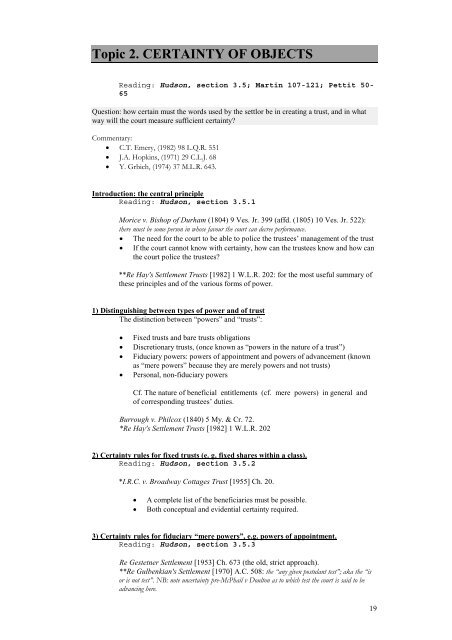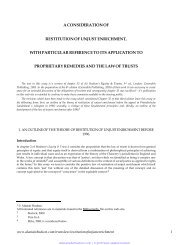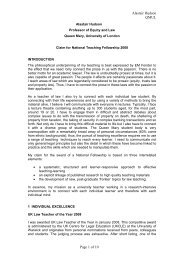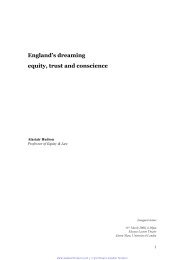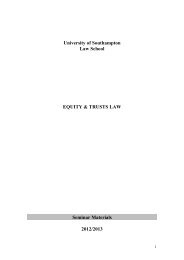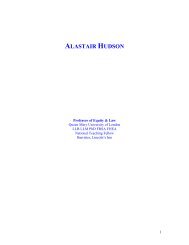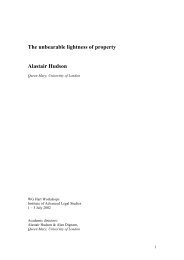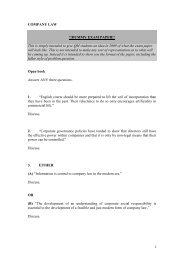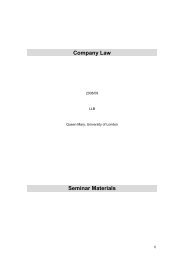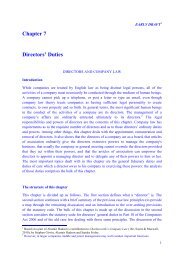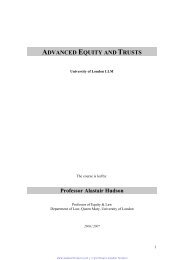Soton Equity and Trusts - alastairhudson.com
Soton Equity and Trusts - alastairhudson.com
Soton Equity and Trusts - alastairhudson.com
Create successful ePaper yourself
Turn your PDF publications into a flip-book with our unique Google optimized e-Paper software.
Topic 2. CERTAINTY OF OBJECTS<br />
Reading: Hudson, section 3.5; Martin 107-121; Pettit 50-<br />
65<br />
Question: how certain must the words used by the settlor be in creating a trust, <strong>and</strong> in what<br />
way will the court measure sufficient certainty?<br />
Commentary:<br />
C.T. Emery, (1982) 98 L.Q.R. 551<br />
J.A. Hopkins, (1971) 29 C.L.J. 68<br />
Y. Grbich, (1974) 37 M.L.R. 643.<br />
Introduction: the central principle<br />
Reading: Hudson, section 3.5.1<br />
Morice v. Bishop of Durham (1804) 9 Ves. Jr. 399 (affd. (1805) 10 Ves. Jr. 522):<br />
there must be some person in whose favour the court can decree performance.<br />
The need for the court to be able to police the trustees’ management of the trust<br />
If the court cannot know with certainty, how can the trustees know <strong>and</strong> how can<br />
the court police the trustees?<br />
**Re Hay's Settlement <strong>Trusts</strong> [1982] 1 W.L.R. 202: for the most useful summary of<br />
these principles <strong>and</strong> of the various forms of power.<br />
1) Distinguishing between types of power <strong>and</strong> of trust<br />
The distinction between “powers” <strong>and</strong> “trusts”:<br />
<br />
<br />
<br />
<br />
Fixed trusts <strong>and</strong> bare trusts obligations<br />
Discretionary trusts, (once known as “powers in the nature of a trust”)<br />
Fiduciary powers: powers of appointment <strong>and</strong> powers of advancement (known<br />
as “mere powers” because they are merely powers <strong>and</strong> not trusts)<br />
Personal, non-fiduciary powers<br />
Cf. The nature of beneficial entitlements (cf. mere powers) in general <strong>and</strong><br />
of corresponding trustees’ duties.<br />
Burrough v. Philcox (1840) 5 My. & Cr. 72.<br />
*Re Hay's Settlement <strong>Trusts</strong> [1982] 1 W.L.R. 202<br />
2) Certainty rules for fixed trusts (e. g. fixed shares within a class).<br />
Reading: Hudson, section 3.5.2<br />
*I.R.C. v. Broadway Cottages Trust [1955] Ch. 20.<br />
<br />
<br />
A <strong>com</strong>plete list of the beneficiaries must be possible.<br />
Both conceptual <strong>and</strong> evidential certainty required.<br />
3) Certainty rules for fiduciary “mere powers”, e.g. powers of appointment.<br />
Reading: Hudson, section 3.5.3<br />
Re Gestetner Settlement [1953] Ch. 673 (the old, strict approach).<br />
**Re Gulbenkian's Settlement [1970] A.C. 508: the “any given postulant test”; aka the “is<br />
or is not test”. NB: note uncertainty pre-McPhail v Doulton as to which test the court is said to be<br />
advancing here.<br />
19


